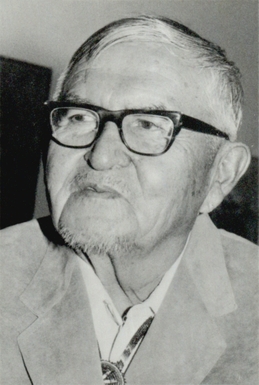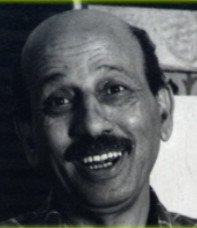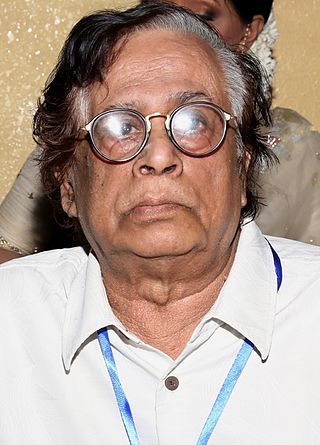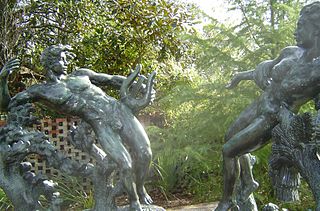Related Research Articles
Munshi Abdur Rouf BS was a Lance Nayek in the 11 Wing of East Pakistan Rifles during the Bangladesh Liberation War. He enlisted in the East Pakistan Rifles on 8 May 1963, and was attached with a regular infantry unit during the War of Liberation. Rouf died on 8 April 1971 at Burighat in Chittagong Hill Tracts after causing extensive damage to the Pakistani Army with his machine gun and forcing them to retreat. He was buried at Naniarchor Upazila in Rangamati District.

Indus Valley School of Art and Architecture is a not-for-profit degree awarding institution in Karachi, Sindh, Pakistan. The university was established in 1989, thereby empowering it to award its own degrees and was the fourth private institution of higher learning in Pakistan to be given a university status. As of 2008, IVS was the third highest ranking art and design university in Pakistan.

Allan Capron Houser or Haozous was a Chiricahua Apache sculptor, painter, and book illustrator born in Oklahoma. He was one of the most renowned Native American painters and Modernist sculptors of the 20th century.

Lubna Agha was an American artist of Pakistani descent who lived in Brookline, Massachusetts.

Henry Spencer Moore was an English artist. He is best known for his semi-abstract monumental bronze sculptures which are located around the world as public works of art. Moore also produced many drawings, including a series depicting Londoners sheltering from the Blitz during the Second World War, along with other graphic works on paper.

Abed Abdi is a Palestinian painter, graphic designer, sculptor and art lecturer.

Bashir Mirza, also known as BM, was a Pakistani painter artist.

José Mariano de Creeft was a Spanish-born American artist, sculptor, and teacher known for modern sculpture in stone, metal, and wood, particularly figural works of women. His 16-foot (4.9 m) bronze Alice in Wonderland sculpture climbing sculpture in Central Park is well known to both adults and children in New York City. He was an early adopter, and prominent exponent of the direct carving approach to sculpture. He also developed the technique of lead chasing, and was among the first to create modern sculpture from found objects. He taught at Black Mountain College, the Art Students League of New York, and the New School for Social Research. His works are in the Whitney Museum, the Metropolitan Museum of Art, the Museum of Modern Art, the Smithsonian American Art Museum, and many other public and private collections.
Pietro Lazzari was an Italian-American artist and sculptor. He is known for his sculptures, paintings, murals, illustrations, and printmaking.

Oviri is an 1894 ceramic sculpture by the French artist Paul Gauguin. In Tahitian mythology, Oviri was the goddess of mourning and is shown with long pale hair and wild eyes, smothering a wolf with her feet while clutching a cub in her arms. Art historians have presented multiple interpretations—usually that Gauguin intended it as an epithet to reinforce his self-image as a "civilised savage". Tahitian goddesses of her era had passed from folk memory by 1894, yet Gauguin romanticises the island's past as he reaches towards more ancient sources, including an Assyrian relief of a "master of animals" type, and Majapahit mummies. Other possible influences include preserved skulls from the Marquesas Islands, figures found at Borobudur, and a 9th-century Mahayana Buddhist temple in central Java.

Syed Afsar Madad Naqvi, was a prominent 20th-century's sculptor. He is best known for his pure realistic monumental sculptures which can be seen in many places around the country. Afsar Madad Naqvi was a master Pakistani sculptor and painter. He was a founder member of the Central Institute of Arts and Crafts Karachi.

Syed Abdullah Khalid was a Bangladeshi sculptor and painter. He was awarded Ekushey Padak by the Government of Bangladesh in February 2017.
Luis Y. Aragón is a Mexican painter and sculptor, best known for his sculpted mural work, as well as the design of the Gawi Tonara award which is given by the state of Chihuahua. His mural work can be found in various parts of Mexico, especially his home state of Chihuahua and Mexico City. His work has been exhibited in Mexico and abroad, generally in the Americas and Europe. He is a member of the Salón de la Plástica Mexicana and works in Mexico City.

Amar Nath Sehgal was a noted Indian modernist sculptor, painter, poet and art educator. He started his career as an engineer in Lahore, and later turned to art. He shifted to Delhi after partition of India in 1947, and in 1950 studied art education from New York University School of Education. Subsequently, became an art educator, teaching at College of Art, Delhi, and in time a noted modern sculptor to his generation. Though he also ventured into painting, drawings and poetry.

Nathaniel Choate (1899-1965) was an American painter and sculptor who served as vice president of the National Sculpture Society. Choate worked with varied materials, including aluminum, bronze, marble, and onyx. He regularly showcased his work at the National Academy of Design in New York City and the Pennsylvania Academy of the Fine Arts in Philadelphia, Pennsylvania. The National Academy of Design elected him an affiliated academician in 1955. In 1961, the Society of Medalists issued their 64th medallion in his honor. Choate also possessed the National Advertising Award from the Outdoor Advertising Association of America.
Humaira Abid is a contemporary artist who was born in Pakistan. The main element she works with is wood. Her recent work combines traditional miniature painting with wood sculpture. Her work examines women's roles, relationships, and taboos from a cross-cultural perspective.

Hamiduzzaman Khan is a Bangladeshi artist and sculptor. He is well known as a sculptor for his theme and form oriented sculptures, in particular sculptures on the theme of Bangladesh War of Liberation and birds. Following the introduction of modernity in sculpture in Bangladesh in the 1950s by Novera Ahmed, Khan was instrumental in the popularization of sculpture in the country through his distinctive form of modernity. Influenced by Alberto Giacometti and Henry Moore, his works manifest expressionism, minimalism, and a constant exploration of purity of material. He worked on both figurative as well as abstract genres.
Lilias Marianne Ar de Soif Farley was a Canadian painter, sculptor, designer, and muralist in realism and abstraction. In 1967, she was awarded the Centennial Medal for Service to the Nation in the Arts. She was an alumna of the Vancouver School of Decorative and Applied Arts and was a member of the school's first graduating class.
Rabia Zuberi, sometimes referred to in Pakistan as Queen Mother of Arts, was a Pakistani sculptor, painter, former chairperson of the Pakistan Arts Council, teacher and Pakistan's first woman sculptor. She produced most of her work after immigrating to Pakistan. Some of her drawings includes Duputta, Quest for Peace, and some sculptures titled Peace Message from the Progressive World and Peace Message were acquired by the National Art Gallery, Pakistan during an exhibition in 2003.
Um Tai-Jung is a representative first-generation abstract sculptor in the Republic of Korea. He graduated from the Department of Sculpture in College of Fine Arts at Seoul National University, studied at Saint Martin's School of Art in London, and held positions as a research professor at Berlin Fine Arts University and professor in the Department of Sculpture in College of Fine Arts at Seoul National University.
References
- ↑ Salman, Peerzada (3 August 2014). "Homage paid to Shahid Sajjad". DAWN.COM. Retrieved 13 July 2020.
- 1 2 Ahmad, Ameer H. (23 February 2010). "Shahid Sajjad – Pakistan's living legend". Daily Times . Retrieved 27 December 2010.
- 1 2 "Transitions: Veteran sculptor Shahid Sajjad passes away". The Express Tribune. 31 July 2014. Retrieved 13 July 2020.
- ↑ Dadi, Iftikhar. "A brief history of Pakistani art and the people who shaped it". Scroll.in. Retrieved 13 July 2020.
- 1 2 "Shahid Sajjad: A Genius For All Times To Come – Profile, Biography -". 6 October 2017. Retrieved 13 July 2020.
- ↑ Bloom, Jonathan; Blair, Sheila S.; Blair, Sheila (14 May 2009). Grove Encyclopedia of Islamic Art & Architecture: Three-Volume Set. OUP USA. ISBN 978-0-19-530991-1.